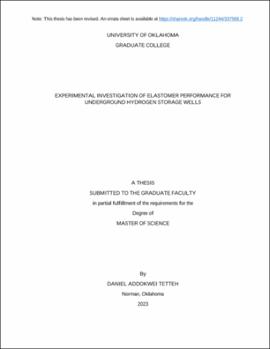| dc.contributor.advisor | Salehi, Saeed | |
| dc.contributor.author | Tetteh, Daniel | |
| dc.date.accessioned | 2023-08-04T21:06:40Z | |
| dc.date.available | 2023-05-05T19:14:31Z | |
| dc.date.available | 2023-08-04T21:06:40Z | |
| dc.date.issued | 2023-05-15 | |
| dc.identifier.uri | https://hdl.handle.net/11244/337569.2 | |
| dc.description.abstract | The "Power-to-Gas" concept is vital in the envisaged Hydrogen Economy as it ensures sustainability and energy security. The process involves converting surplus energy from various sources like conventional fossils, wind and solar into hydrogen for storage in underground structures and reproducing them during periods of high energy demand. Depleted hydrocarbon reservoirs are the most common underground structures for hydrogen storage. Being a relatively new concept, Underground Hydrogen Storage (UHS) in depleted hydrocarbon reservoirs is associated with challenges related to several aspects of well integrity, including elastomers as seen in well bore seal assemblies.
This study investigates the behavior of general-purpose oil and gas industry elastomers in UHS environments. Three general-purpose elastomers, Ethylene Propylene Diene Monomer (EPDM), Flouroelastomers (FKM), and Nitrile Butadiene Rubber (NBR), are exposed to varied gas mixtures at different aging conditions via autoclave aging experiments and their physio-mechanical properties examined. In addition, observed cavities on the elastomers are statistically analyzed to ascertain the onset of elastomer failure due to cavity formation. Furthermore, changes in the surface morphology of elastomers due to aging were also investigated via Scanning Electron Microscopy (SEM). The result showed that exposure of elastomers to gaseous hydrogen environments at the specified environmental conditions causes changes in their physio-mechanical properties which may subsequently result in material failure.
Furthermore, two main phenomena were identified to be the primary cause the changes in the mechanical properties of elastomers samples for the given test conditions: Plasticization effect by gases and elastomer chain rupture or cross-linkage formations due to chemical ageing. Carbon dioxide was identified to have the most deteriorative effect on the mechanical properties of elastomers due to its low diffusivity coefficient and high plasticization effect on polymer chains. The effects of pure hydrogen and hydrogen-methane mixtures on the mechanical properties of elastomers were identified to be similar. EPDM showed increased hardness and compressional resistance when aged in 100% hydrogen and hydrogen-methane mix environments at high temperatures and poor compressional resistance at low temperatures. EPDM also maintained its thermal resistance properties in gaseous hydrogen environments. The most significant elastomer degradation in gaseous hydrogen environments was seen in NBR. FKM remained thermally stable in gaseous hydrogen environments, although its compressional resistance reduced at elevated temperatures. Furthermore, SEM showed rougher surfaces of EPDM and NBR elastomers after aging in a pure hydrogen environment at 70oC for 7 days, which was proposed to be due to the formation of cross-links. Also identified on the surface of these elastomers after aging are haphazardly distributed micro-cavities and precipitates proposed to be additives used in material production. Finally, statistical analysis indicated that for all samples aged in 100% H2 and (50% H2 + 50% CH4) for 3 days at 70oC, there is statistical evidence of cavity formation due to aging except for NBR samples aged in 100% H2 at 70oC for 3 days. | en_US |
| dc.language | en_US | en_US |
| dc.subject | Hydrogen | en_US |
| dc.subject | Elastomers | en_US |
| dc.subject | Well Integrity | en_US |
| dc.subject | Underground Hydrogen Storage | en_US |
| dc.title | Experimental investigation of elastomer performance for underground hydrogen storage wells | en_US |
| dc.contributor.committeeMember | Ahmed, Ramadan | |
| dc.contributor.committeeMember | Karami, Hamidreza | |
| dc.date.manuscript | 2023-05-05 | |
| dc.thesis.degree | Master of Science | en_US |
| ou.group | Mewbourne College of Earth and Energy::Mewbourne School of Petroleum and Geological Engineering | en_US |
| shareok.orcid | https://orcid.org/0000-0002-7888-1413 | en_US |
| shareok.nativefileaccess | restricted | en_US |
| dc.description.notes | This thesis has been revised, with changes approved by the Graduate College on June 24, 2023. The original version is available at: https://shareok.org/handle/11244/337569 | en_US |

